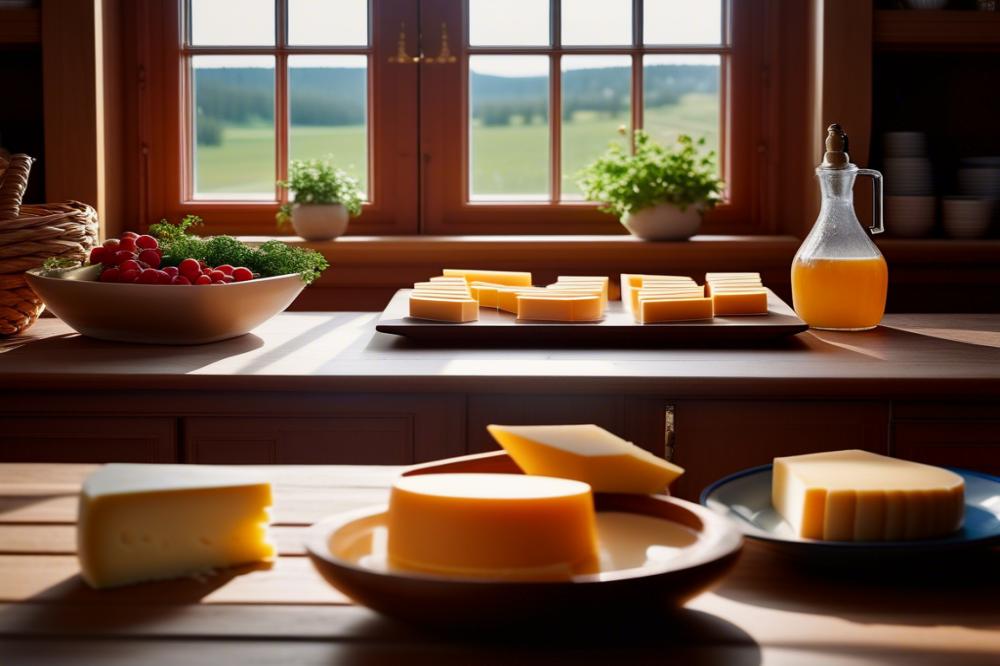Introduction
brown cheese holds a special place in Sweden’s culinary landscape. This delight has its roots deep in Scandinavian history, tracing back several centuries. Originally made by farmers, it arose from the need to preserve milk and utilize every part of it. Today, brown cheese is a beloved staple that brings nostalgia to many Swedes.
In Swedish culture, this cheese is more than just a food item; it represents tradition and community. Family gatherings often feature stories and memories associated with its taste. One cannot talk about this creamy treat without mentioning its two main varieties: Mesost and Messmör. Both are traditional forms of Swedish cheese that showcase distinct flavor profiles and textures.
Mesost, often referred to as “sweet cheese,” tends to be firmer with a caramel-like flavor. It is typically enjoyed in thin slices, paired with crispbread or utilized in various dishes. On the other hand, Messmör is a spreadable form of the cheese. This variant boasts a softer consistency and can be generously slathered on bread, making it a favorite for breakfast or snacks.
Overall, these cheese varieties are integral to Swedish culinary heritage. Their different characteristics allow for versatility in meals. Whether incorporated into recipes or savored on their own, mesost and messmör truly enliven the table while celebrating Sweden’s rich history and culture.
Brown Cheese

Brown cheese is a fascinating part of Sweden’s culinary landscape. This dairy product is distinctive for its caramel-like sweetness and rich flavor. Made primarily from whey, the production process involves cooking the whey down to remove most of its moisture. The process caramelizes the lactose, giving the cheese its brown color and unique taste.
The primary ingredients include whey, cream, and often a bit of salt. Sometimes, milk is added to achieve a different texture and flavor. Cheeses are then pressed into molds and aged for varying lengths of time. The texture usually ranges from smooth and spreadable to firmer varieties that can be sliced.
Types of Brown Cheese
In Sweden, you will find two notable types: mesost and messmör. Both have a distinct place in Swedish culture and cuisine, yet they differ in several important ways. Mesost is the firmer type. You can slice it and use it in sandwiches or as part of a cheese platter. The taste is subtly sweet, with a rich, complex flavor that pairs wonderfully with fruits or jams.
Messmör, on the other hand, is a spreadable variant. Its smoother texture makes it ideal for spreading on crispbread or in recipes. The taste of messmör is also sweet but tends to be less intense than that of mesost. This product has a more pronounced creaminess, which contributes to its usage in various dishes.
Taste Profile and Culinary Applications
Each type of cheese enhances different culinary experiences. Mesost can be enjoyed on its own as a snack. Many people love to combine it with slices of apples or serve it with dark bread. Messmör is often used as a spread at breakfast or as an accompaniment to pastries. Sometimes, it is even incorporated into desserts or sweet sauces.
In summary, while both mesost and messmör stem from the same rich tradition of brown cheese in Sweden, their textures and flavors lead to different culinary uses. Each provides a way to experience the unique taste of Swedish cuisine, making them cherished favorites among locals and visitors alike.
Swedish cheese

Sweden boasts a rich variety of cheeses beyond just its famous brown cheese. Among the many options available, you can find both hard and soft cheeses made from cow, goat, and sheep milk. Feta-style cheeses are popular, often featuring a tangy flavor. Västerbotten cheese stands out for its hard texture and sharp, distinct taste. This cheese is often compared to aged cheddar and is a common ingredient in traditional dishes.
Another notable cheese is Grevé, which is semi-hard and has a nutty flavor. This cheese melts beautifully, making it perfect for cooking in casseroles or on pizzas. Different regions contribute unique flavors to their cheeses. For example, in southern Sweden, creamy cheeses like Svecia are celebrated for their mild taste and smooth texture.
Local ingredients play a vital role in cheese production. Farmers use milk from animals that graze on wildflowers and natural pastures. This results in flavors that truly reflect the land of Sweden. Traditional cheese-making methods, many passed down through generations, emphasize quality and artisanal techniques. Makers often rely on natural rennet and cultures, showing a commitment to time-honored practices.
The diversity of milk types used further enhances the range of cheeses. Goat’s milk, for instance, gives a tangy bite to cheeses that often appeal to adventurous eaters. Artisan cheesemakers focus on small batches, allowing for greater attention to detail. Seasonal variations in milk yield different tastes depending on the time of year.
Among the soft cheeses, you will find options like Kärnan, which has a mild flavor and creamy consistency. It pairs well with fruit or spreads, making it a favorite at gatherings. Additionally, various blue cheeses are produced in Sweden, each offering its own level of richness and sharpness. The balance between sweet and savory offers a delightful experience for cheese lovers.
Swedish cheese is more than just a food item; it encapsulates a part of the culture. Celebrations often include cheese platters, where people share both new and traditional favorites. By enjoying these cheeses, one can taste the love and dedication of Swedish farmers and artisans. Each cheese tells a story that connects consumers to the land and heritage of Sweden.
Recipe: Messmör Spread

Messmör is a delicious Swedish brown cheese spread that can enhance many snacks and meals. Making this spread at home is simple and quick. With just a few ingredients, you can enjoy a flavorful addition to your breakfasts or evening snacks.
Ingredients
- 200g messmör (Swedish brown cheese spread)
- 50g softened butter
- 1 tbsp honey or syrup (optional)
- Pinch of salt
Instructions
- In a bowl, combine messmör and softened butter until the mixture is smooth.
- Add honey or syrup for extra sweetness if you like, and mix well.
- Include a pinch of salt to taste, incorporating it into the mixture.
- Spread messmör on crispbread or toasted bread for a delightful treat.
- Pair it with a refreshing glass of milk or coffee to complete your snack.
Nutritional Information
One serving of messmör provides a great source of energy. Typically, it contains around 120 calories, with a good balance of fats and proteins. A typical serving offers about 8g of fat and 6g of protein, making it satisfying.
Vitamins and minerals also play a significant role in its benefits. It contains calcium, which supports strong bones, and vitamin B12, which is essential for nerve health. In addition, the unique combination of nutrients can help boost energy levels throughout the day.
Using this cheese spread in your meals can provide more than just flavor. It adds nutritional value and variety. When enjoyed in moderation, this delightful option can be a part of a balanced diet that supports overall wellness.
Embracing Sweden’s Brown Cheese Heritage
Brown cheese holds a special place in Swedish cuisine and culture. It is more than just a tasty food item; it represents a tradition woven into the fabric of everyday life. This delightful cheese, made primarily from whey, offers a sweet and caramel-like flavor that many Swedes cherish. Both mesost and messmör highlight the country’s innovative approach to dairy products, showcasing a sustainable way to make use of ingredients.
Health-wise, these brown cheese varieties provide nutritional benefits. They are rich in protein and calcium, making them great choices for snacking or adding to meals. Trying these cheeses can be a way to enjoy something that not only satisfies the taste buds but also promotes well-being. With their creamy texture, both mesost and messmör can elevate simple dishes, from sandwiches to desserts.
Readers are encouraged to explore the world of Swedish cheese beyond just these two types. The diversity among cheeses in Sweden reflects the country’s rich farming traditions and artisanal cheese-making practices. Each cheese has its own story, often tied to specific regions and local customs. By delving into this culinary journey, one can appreciate the dedication that goes into creating such delicious products.
So, don’t miss out on experiencing mesost and messmör firsthand. Be adventurous and include these flavorful cheeses in your next meal. Expanding your palate to include these brown delights means embracing a part of Swedish culture. Enjoying this unique aspect of Sweden will surely add depth to your culinary experiences.



